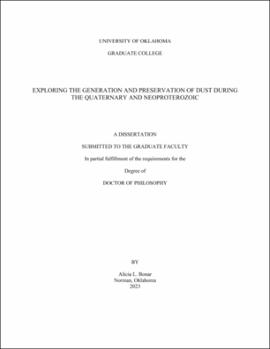| dc.description.abstract | Global sediment movement and production are important to understand when reconstructing Earth’s past geography and climate. Loess—terrestrial sedimentary deposits composed of predominantly eolian-transported silt—record the most complete records of climate in the nonmarine realm and some of the largest concentrations of dust in Earth’s geologic record. The goals of this dissertation are to 1) test hypotheses related to the on-going debate surrounding the generation of abundant fine-grained material that accumulates as loess deposits, and 2) identify and characterize the sediment transport mechanisms and depositional environments of a massive and structureless sedimentary sequence in Tanzania, which is herein interpreted as a record of Neoproterozoic loess. This abstract aims to illustrate the connections and relationships between the three chapters submitted as part of this dissertation. Each chapter is formatted for publication in various peer-reviewed scientific journals, including the Journal of Geophysical Research (American Geophysical Union) and the Journal of African Earth Sciences (Elsevier).
Many processes have been proposed to be efficacious mechanisms in the production of silt. These include glacial grinding, eolian saltation, fluvial comminution, and many types of weathering such as insolation-, salt-, frost- and pedogenic weathering. While processes such as glacial grinding and eolian saltation have been extensively studied to illustrate their efficacy for generating silt, pedogenic weathering has not been tested rigorously, either by experimental or empirical studies. Chapter I aims to test this hypothesized mechanism for silt generation by comparing granulometric data and major, trace, and rare earth element geochemistry of two modern soils from varying climates (hot-arid and hot-humid), in order to discern whether the silt fraction formed in situ (autochthonous) or was sourced from eolian processes (allochthonous). Granulometric results indicate that the hot-humid soil (located in southeastern Puerto Rico) contains abundant (>70%) silt- and clay-sized grains (average mode ~15 µm), while the hot-dry soil (located in southern California) contains very minimal silt-sized material (<6%; average mode ~40µm); additionally, geochemical results indicate the Puerto Rico silt- and clay-fraction is at least partially derived from eolian inputs (e.g., African dust, Lesser Antilles volcanic ash) and the Anza Borrego silt-fraction is indistinguishable from local and regional dust sources (e.g., Greater Mojave Desert dust). Therefore, the results from Chapter I suggest pedogenic weathering is not a significant factor in silt production for geologically significant loess deposits, as the Puerto Rico soil contains significant silt in a grain-size fraction finer than typical loess, and the Anza Borrego soils contains essentially no in situ silt.
Chapters II and III of this dissertation concentrate on describing, analyzing, and interpreting the provenance, sediment transport mechanisms, and depositional environment of the Neoproterozoic Manyovu redbeds in western Tanzania, which we interpret as a partial record of loess. The Manyovu redbeds are a unique, and understudied, sedimentary deposit that records extreme tectonic and climatic shifts in Earth history, such as supercontinent assembly as well as major climatic shifts including the enigmatic Snowball Earth events. First, we utilized U-Pb detrital zircon geochronology and modal composition trends to better constrain the age and source of sediment preserved in the Manyovu strata (Chapter II). U-Pb detrital zircon ages indicate maximum depositional ages (MDAs) as young as 613.6 ± 1.2 Ma, which is almost 200 Ma younger than the previously dated, underlying lavas. Additionally, detrital zircon age spectra and modal compositions indicate the sediment for the Manyovu redbeds was both locally and regionally sourced, and the mid-Manyovu strata likely record the initiation of Pan-African Orogenesis in the Mozambique Belt of Eastern Africa.
After determining the new age constraints and provenance for the Manyovu redbeds, we utilized field observations, particle-size analysis, and supplementary geochemical data to better constrain the depositional environment (Chapter III). Previous work had described the Manyovu redbeds as thick, massive, monotonous, red sandstone, and interpreted the deposits as shallow marine rocks. We logged a 285-m section, where we found no evidence for water-laid deposition of these units. The strata lacked sedimentary structures, channelization, and erosive contacts; instead, a significant fraction of the Manyovu redbeds studied is internally massive, fine-grained (silt – fine sand), and exhibits blocky fracture patterns, concretion horizons, and microfabrics indicative of pedogenesis. Based on these observations, we reinterpret the Manyovu redbeds as recording deposition in a continental, eolian-dominated setting. Together, Chapters II and III redefine the Manyovu redbeds as at least late Cryogenian to Ediacaran in age, consisting of mostly loess and pedogenically altered loess that may record periglacial deposition, yielding broad implications for Neoproterozoic paleoclimate and Pan-African Orogenesis in East Africa. | en_US |
